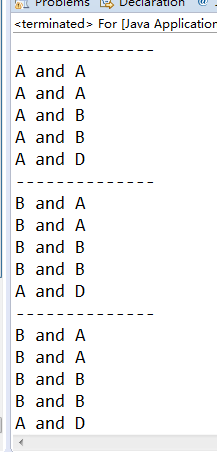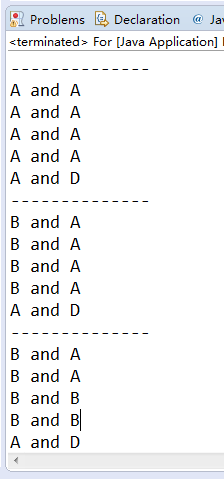假设定义了class A;
再在定义class B extends A;
我们可以这样定义一个对象:A a = new B();
栈中的引用变量是A,堆中的实例变量是B。
将子类的实例,赋值给父类的引用。就是向上转型。
向上转型,在运行时,会遗忘子类对象中与父类对象中不同的方法。也会覆盖与父类中相同的方法–重写。(方法名,参数都相同)
所以a2,可以调用的方法就是,A中有的,但是B中没有的方法,和B中的重写A的方法。
java 的这种机制遵循一个原则:当超类对象引用变量引用子类对象时,被引用对象的类型而不是引用变量的类型决定了调用谁的成员方法, 但是这个被调用的方法必须是在超类中定义过的,也就是说被子类覆盖的方法。
实例:
public class A {
public String show(D obj) {
return ("A and D");
}
public String show(A obj) {
return ("A and A");
}
public String show(B obj) {
return ("A and B");
}
}public class B extends A {
public String show(B obj) {
return ("B and B");
}
public String show(A obj) {
return ("B and A");
}
}
public class C extends B{
public C() {
// TODO Auto-generated constructor stub
}
}public class D extends B{
public D() {
// TODO Auto-generated constructor stub
}
} A aa1 = new A();
A a2 = new B();
B b = new B();
C c = new C();
D d = new D();
System.out.println(aa1.show(aa1));// A and A
System.out.println(aa1.show(a2));// A and A
System.out.println(aa1.show(b)); // A and A
System.out.println(aa1.show(c)); // A and A
System.out.println(aa1.show(d)); // A and D
System.out.println("--------------");
System.out.println(a2.show(aa1));// B and A //使用class B 中的方法show(A obj)
System.out.println(a2.show(a2));// B and A //使用class B 中的方法show(A obj)
System.out.println(a2.show(b)); // B and B //使用class B 中的方法show(B obj)
System.out.println(a2.show(c)); // B and B //使用class B 中的方法show(B obj)
System.out.println(a2.show(d)); // A and D //使用class A 中的方法show(D obj)
System.out.println("--------------");
System.out.println(b.show(aa1));// B and A
System.out.println(b.show(a2));// B and A
System.out.println(b.show(b)); // B and B
System.out.println(b.show(c)); // B and B
System.out.println(b.show(d)); // A and D
}结果:
这里是比较好理解的,但是我们把改一下class A,将其改为:
public class A {
public String show(D obj) {
return ("A and D");
}
public String show(A obj) {
return ("A and A");
}
// public String show(B obj) {
// return ("A and B");
// }
}也就是在class A中不重载show(B obj)方法,其余不变,执行后的结果图:
发现只有
System.out.println(a2.show(b)); //修改之前B and B 之后 B and A
System.out.println(a2.show(c)); //修改之前B and B 之后 B and A这两句的输出发生了改变,根据文章开头的叙述不难理解,由于修改过的class A中并没有show(B obj)方法,所以当我们向上转型后,class B中重载的show(B obj)被遗忘了,class B中重写的方法被保留,也就是说,此时class B中的内容相当于:
public class B extends A {
public String show(A obj) {//重写了父类中的方法
return ("B and A");
}
public String show(D obj) {//从父类继承
return ("A and D");
}
}























 3480
3480

 被折叠的 条评论
为什么被折叠?
被折叠的 条评论
为什么被折叠?








